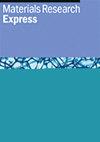受生物启发,利用肉豆蔻种子绿色合成铜、镍和混合纳米粒子:生物医学应用及其他
IF 2.2
4区 材料科学
Q3 MATERIALS SCIENCE, MULTIDISCIPLINARY
引用次数: 0
摘要
纳米技术主要研究分子和原子级别的材料,其尺寸从 0.1 纳米到 100 纳米不等。本研究利用肉豆蔻的水性种子提取物,探讨了氧化铜(CuO)、氧化镍(NiO)和混合纳米粒子的合成和表征。这些纳米材料采用了多种技术进行综合表征:紫外分析、傅立叶变换红外光谱、XRD、TGA、EDX 和 SEM。我们通过抗氧化和抗菌试验探索了纳米材料的生物应用。紫外分析确定了 CuO、NiO 和混合纳米粒子的光吸收光谱值。傅立叶变换红外光谱分析证实了植物提取物中负责封盖和还原反应介质的官能团。XRD 和 SEM 分析表明了纳米粒子的结晶性质和形态。氧化铜纳米粒子呈现多面体形态,而氧化镍纳米粒子主要呈球形,并有一些团聚。与氧化铜和氧化镍纳米粒子相比,氧化铜-氧化镍杂化纳米粒子呈现出明显的团聚和更大的平均尺寸的钨锆石形态。EDX 显示铜和镍的含量较高。XRD 光谱显示了纳米粒子的平均粒径。TGA 显示了纳米颗粒的热稳定性,其中混合纳米颗粒最为稳定。这些纳米粒子表现出优异的抗氧化活性,其中混合纳米粒子在总抗氧化能力、总还原力(TRP)、ABTS 试验和 DPPH 自由基清除试验中均表现出最高值(400 μg/mg)。针对耐多药细菌菌株的抗菌试验表明,抗生素包覆的混合纳米粒子对金黄色葡萄球菌、大肠杆菌和绿脓杆菌具有很强的抗菌性能。总之,由肉豆蔻香料介导的 CuO、NiO 和 CuO-NiO 混合纳米粒子在各种应用中,特别是在生物医学和临床环境中,展现出了良好的特性。这些纳米粒子的合成过程对环境友好,而且具有生物相容性,因此对未来的研究和开发具有吸引力。本文章由计算机程序翻译,如有差异,请以英文原文为准。
Bioinspired green synthesis of copper, nickel, and hybrid nanoparticles using Myristica Fragrans seeds: Biomedical applications and beyond
Nanotechnology focuses on materials at the molecular and atomic levels, with sizes ranging from 0.1 to 100 nm. This study explores the synthesis and characterization of copper oxide (CuO), nickel oxide (NiO), and hybrid nanoparticles using an aqueous seed extract from Myristica fragrans. The nanomaterials underwent comprehensive characterization employing various techniques: UV analysis, FTIR spectroscopy, XRD, TGA, EDX and SEM. We explored their biological applications through antioxidant and antibacterial assays. UV analysis determined the optical absorption spectra values for CuO, NiO and hybrid nanoparticles. FTIR analysis confirmed functional groups in the plant extract responsible for capping and reducing the reaction medium. XRD and SEM analysis demonstrated the crystalline nature and morphology of the nanoparticles. CuO nanoparticles exhibited polyhedral morphology, while NiO nanoparticles were primarily spherical with some agglomeration. The CuO-NiO hybrid nanoparticles showed a wurtzite morphology with significant agglomeration and larger mean size than CuO and NiO nanoparticles. EDX indicated higher quantities of Cu and Ni. XRD spectra revealed the average particle sizes of nanoparticles. TGA indicated the thermal stability of the nanoparticles, with hybrid nanoparticles being the most stable. The nanoparticles exhibited excellent antioxidant activity, with hybrid nanoparticles showing the highest values in measuring total antioxidant capacity, total reducing power (TRP), ABTS assay, and DPPH-free radical scavenging assay at 400 μg/mg. Antibacterial assays against multidrug-resistant bacterial strains demonstrated that antibiotics-coated hybrid nanoparticles exhibited potent antibacterial properties against Staphylococcus aureus, Escherichia coli, and Pseudomonas aeruginosa. In conclusion, CuO, NiO, and CuO-NiO hybrid nanoparticles mediated by Myristica fragrans showcase promising characteristics for various applications, especially in biomedical and clinical settings. The nanoparticles eco-friendly synthesis and biocompatible nature make them attractive candidates for future research and development.
求助全文
通过发布文献求助,成功后即可免费获取论文全文。
去求助
来源期刊

Materials Research Express
MATERIALS SCIENCE, MULTIDISCIPLINARY-
CiteScore
4.50
自引率
4.30%
发文量
640
审稿时长
12 weeks
期刊介绍:
A broad, rapid peer-review journal publishing new experimental and theoretical research on the design, fabrication, properties and applications of all classes of materials.
 求助内容:
求助内容: 应助结果提醒方式:
应助结果提醒方式:


